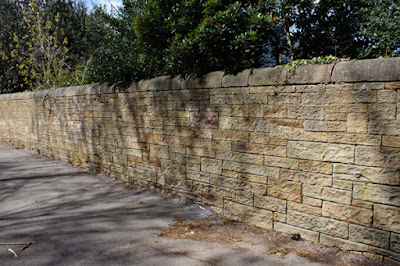 |
| A detail of an old boundary wall on Norfolk Park Road |
Leaving Jervis Lum, I followed the Lime Avenue down to the West Lodge of Norfolk Heritage Park, where the sandstone used for the masonry, with its ‘ginger nut’ hue, looks very similar to the stone used at Arbourthorne Cottages, which was also built in 1841.
Next door to the entrance to the park, the house at No. 45 Norfolk Park Road has a different character, with the northern part of the building being relatively pale in colour, with slightly darker sandstone used in the southern part and no obviously orange sandstone anywhere.
This is presumably of the same date as the Grade II Listed Beech Hill, a house built c.1831 for the 12th Duke of Norfolk and extended in 1859. Now converted to use by the NHS, with access to the property being a bit limited, I just took a few general photographs.
The best view of the east elevation does show a bit more colour variation than No. 45 Norfolk Park Road, as does the walling to the old coach house, where there is a considerable proportion of orange sandstone stained sandstone.
According to to “Hunt’s Mineral Statistics”, the Duke of Norfolk owned several quarries in Sheffield in 1858 – including the nearby Clay Wood and Arbourthorne quarries on the Silkstone Rock, the Hyde Park quarry on the Parkgate Rock and a ‘bluestone’ quarry in Handsworth.
Having only a small sample of Silkstone Rock and seen limited exposures in the old Clay Wood Quarry and the Sheffield railway station cutting, and not knowing accessible reference buildings where any of the above have been definitely used, documentary evidence is needed to determine the provenance – a problem with very many of the sandstones seen in Sheffield.
When matching stone in the building restoration industry, where I developed a skill for detecting subtle variations in colour and texture, I know the value of ‘getting your eye in’ and, although I only took a few moments to photograph it, the crest on Beech Hill looks like it could have been carved from Ancaster limestone and not sandstone.
Some building stones have such a distinctive physical characteristics that are easily recognised, such as the very coarse grained massive sandstone used for the gate piers at the entrance to Beech Hill, which was once known as the Rivelin Grit.
Now named the Chatsworth Grit, which forms the ‘Millstone Grit edges’ of Derbyshire and along the Rivelin Valley, it typically contains beds of rounded pebbles often more than 10 mm in diameter, which were formed at the bottom of the large river channels that formed deltas during the early part of the Upper Carboniferous Period.
Continuing westwards along Norfolk Park Road, there is an interesting contrast between the boundary walling on the north and south sides of the roads, with the former being built with larger blocks of light brown sandstone, with pronounced iron staining in places, but the latter has thinner, more irregularly sized and coursed blocks, which are very often blackened.
Again, the provenance of the stone is unknown, but looking closely, the older south wall contains a high proportion of grey silty sandstone that looks very similar to the sample that I collected from the undifferentiated Pennine Lower Coal Measures Formation in Jervis Lum. It is of a quality that is only suited to basic boundary walling and, in places, I noted that it is weathering back into sand.











No comments:
Post a Comment